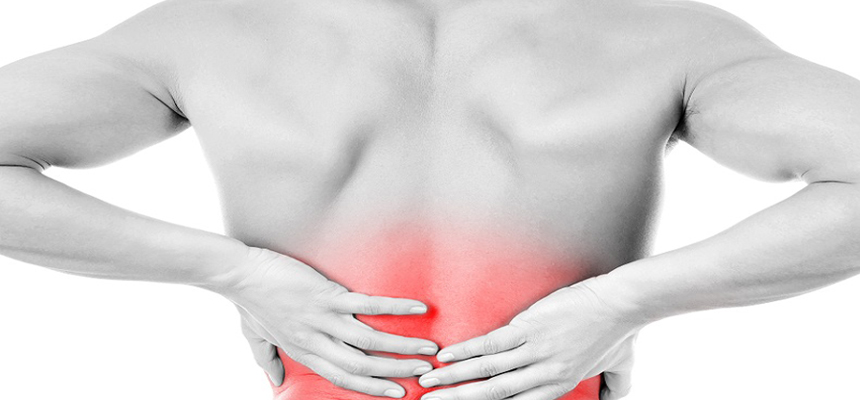Mind your Back before it gives you pain

 Back pain is a common problem that dispirits our lives. It has been observed that 8 of 10 people normally complain of back pain. According to the data from Indian Survey of Spine Diseases, about 48-60% of people in India is suffering from or suffered once in their life from back pain issue. About 20% of this group belongs to 16 to 34 years age. Back issues can affect nearly every aspect of your everyday activities from sitting to standing to lying down. Dr. Randhir MS, MCh, FIMSS, Sr Consultant Neurosurgeon, Virinchi Hospitals talks about back pain.
Back pain is a common problem that dispirits our lives. It has been observed that 8 of 10 people normally complain of back pain. According to the data from Indian Survey of Spine Diseases, about 48-60% of people in India is suffering from or suffered once in their life from back pain issue. About 20% of this group belongs to 16 to 34 years age. Back issues can affect nearly every aspect of your everyday activities from sitting to standing to lying down. Dr. Randhir MS, MCh, FIMSS, Sr Consultant Neurosurgeon, Virinchi Hospitals talks about back pain.
Q1: Why do think there is a sudden rise in back pain amongst people?
The sudden rise in back pain is mostly because of the working lifestyle, inappropriate posture of sitting & sleeping, lack of exercise, sedentary lifestyle. The close room syndrome leads to vitamin D3 deficiency. Other reasons could belong to two-wheeler driving, excessive smoking leading to early weakness of the bones. Sometimes gynecological problems like pcod, fibroids & PID leading to the non-specific back pain in females. Urinary tract infection & tubercular infections can lead to chronic back pain.
Q2: What are the various categories of back pain?
The sudden onset of back pain also called lumbar sprain or lumbago which is most common. Slipped disc or sciatica pain in which severe back pain & leg pain, either one or the both of the legs associated with tingling & numbness sensation. The non-specific back pain of more than 6-week duration which may include spinal, instability or listless. Severe back pain associated with foot drop or weakness in the leg or involvement of urine and motion incontinence, it is a spinal emergency called cauda equine syndrome.
Spinal infection can lead to back pain, fever, weight loss, most common TB infection in India. Other types of back pain are Rheumatoid Arthritis of Spine, Ankylosing Spondylitis, Osteoporosis Spinal Fractures and Fibromyalgia
Q3: What are its symptoms?
Severe back pain with leg pain associated with tingling & numbness or foot drop may indicate acute disk prolapsed. Back pain associated with leg pain which may increase during walking off a few meters may indicate stenosis or compression of spinal nerves or instability of spinal column: mostly seen in aging spine. Weakness in the leg, loss of sensation, urinary & motion difficulty, foot drop indicates a spinal emergency.
Q4: What are the conventional approaches to treatment to reduce back pain?
Nearly 70 to 80% of back pain subsides with conservative or medical/rest/physiotherapy. Mild painkiller with muscle relaxant is needed. Rest not more than 24hrs, local heat pad & local spray are advised along with Vitamin D3/vitamin B12 supplements. For pure vegetarians, Vitamin B12 levels are very low, so supplements are required. Patients need physiotherapy which includes USG massage, IFT & lumbar extension exercises. Generally, lumbar extension exercise to be started after acute pain symptom subsides. Two wheeler driving should be avoided during this phase. Patients should avert from lifting weight in a bending posture & encouraged to use a western toilet. If a symptom does not improve in spite of these conservative treatments for 4 weeks, then x-ray/MRI spine is advised.
Q5: Is there any latest therapy or surgery adopted by a doctor to treat spinal or back issue?
The latest treatment for spinal disorder includes:
![]() Endoscopic spinal surgery
Endoscopic spinal surgery
![]() Microscopic spinal surgery
Microscopic spinal surgery
![]() Laser & radiofrequency treatment
Laser & radiofrequency treatment
![]() Artificial disc replacement
Artificial disc replacement
![]() Keyhole or minimally invasive spinal fixation surgery
Keyhole or minimally invasive spinal fixation surgery
![]() These are minimal invasive day care surgery for early recovery & fewer traumas to the patients.
These are minimal invasive day care surgery for early recovery & fewer traumas to the patients.
Q6: When do you advise for spine surgery?
The surgery for the spine is very specific; the majority of the spinal problem can be treated with medicines for an early stage of 4 to 6 weeks. If pain persists in spite of medical treatment and MRI spine shows acute disc prolapse, then surgery is advised. If there is any indication of weakness in the legs or footdrop or numbness in legs or in the groin area or involvement of urine or motion, urgent surgery is adviced. One should not neglect these symptoms because, earlier the surgery, better the results. The major cause of partial recovery after spinal surgery may be due to the delayed decision making for operations. First surgery of the spine is the best surgery so in case you have been advised for surgery, kindly gets the best opinion from a specialist. Understanding your spinal problem from your consultant and ask for the best available treatment.
Q7: what would you advise people who suffer from spinal issue due to the wrong postures?
![]() Use a mattress which is not too hard or too soft.
Use a mattress which is not too hard or too soft.
![]() Use pillow according to your comfort.
Use pillow according to your comfort.
![]() Don’t sleep on the floor.
Don’t sleep on the floor.
![]() Just after getting from the bed, do 5 to 10 minutes do back stretching exercises.
Just after getting from the bed, do 5 to 10 minutes do back stretching exercises.
![]() Moderate to brisk walking for 30 to 45 minutes include it in a daily routine.
Moderate to brisk walking for 30 to 45 minutes include it in a daily routine.
![]() In office or workplace on your sitting chair, keep your back in an erect posture.
In office or workplace on your sitting chair, keep your back in an erect posture.
![]() With proper back support.
With proper back support.
![]() Do not sit in one place for more than 2 hours. Take 5 minutes gap in between to walk & relax your back.
Do not sit in one place for more than 2 hours. Take 5 minutes gap in between to walk & relax your back.
![]() Try to quit smoking.
Try to quit smoking.
![]() Use a healthy diet rich in Vitamin D3 & Vitamin B12.
Use a healthy diet rich in Vitamin D3 & Vitamin B12.
![]() Useless crab & high protein diet.
Useless crab & high protein diet.
![]() It’s your back, your choice.
It’s your back, your choice.

 Disclaimer: Welthi.com does not guarantee any specific results as a result of the procedures mentioned here, and the results may vary from person to person.
Disclaimer: Welthi.com does not guarantee any specific results as a result of the procedures mentioned here, and the results may vary from person to person.









